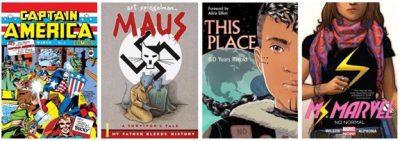HIST 3909B: History Through Comic Books
Fall 2023
Instructor: Amie Wright
From the first appearance of Captain America (1941) punching the face of Hitler, comics have been important facets of North American social and cultural history–albeit often under considered ones. This course introduces students to ‘Graphic History’ – history told through and taught using comics and graphic novels. Covering the early twentieth century to the present, this course considers comic books and graphic novels as historical documents and historical representations. Specific topics this course will cover include: the 1950s comics censorship campaigns and legislation under the Canadian Criminal Code, comics and their use in public history, the growth of the Canadian comics industry, current comic bans and challenges, as well as future potentials for graphic history.
This class will review notable works of Graphic History including Maus alongside recent titles including award winning Canadian texts, This Place: 150 Years Retold and Ducks: Two Years in the Oil Sands by Kate Beaton. Building on the work of visual literacy scholar Nick Sousanis, this class will be focused on ‘unflattening’ fixed viewpoints of what we consider to be ‘Graphic History’ and will discuss a spectrum of visual historical narratives including political cartoons and superhero comics – such as Captain America and newer figures like Ms. Marvel Kamal Khan – alongside nonfiction graphic novels.
This course situates comics within the larger growing landscape of visual narratives and formats used in the telling, teaching, and understanding of public history including zines, video games, and digital platforms. This class queries ideas of what is a historical ‘document’ and in doing so interrogates our own practice(s) as public historians.
Schedule dependent, this course will host visits from Library & Archives Canada and/or Library of Congress curators to discuss comics as cultural and historical artifacts, as well as guest lectures from comics creators and publishers.
Learning objectives of this class include:
- understanding how to read, analyze, and decode the textual and visual language of comics
- introducing some canonical and emerging works and formats of graphic history
- recognizing the multiplicity of formats that ‘comics’ encompasses (linear storytelling, juxtaposed narrative, physical books, online webcomics, multimodal mass media, etc.)
- analyzing how graphic history can address historical gaps and add to public history practice
- considering our own ways of knowing the past and positionalities
- What do we consider ‘authoritative’ teaching materials?
- What do we consider ‘historical documents’?
- What do we know about comic books and graphic novels?
- What were we (previous to this class) taught about comics and graphic novels? Were they encouraged/discouraged in our schools, libraries or families? How does that impact our practice and understandings of comics and graphic novels?
As a Graphic History class, we will be reading comics every week; however, this class is open to all – whether you have read a comic or graphic before or not. Comics and graphic novels are for everyone and are a vital part of our visual cultural histories.
Questions? Please email amiewright@cunet.carleton.ca
NOTE on Terminology: This course, following the use by many comics creators and scholars, uses the umbrella term ‘comics’ to refer to bande dessinée, comic books, comic strips, graphic novels, manga, manhwa, political cartoons, webcomics, and zines. What many might not know is that the term ‘graphic novel’ started in the late 1970s as a rebranding campaign by comics creators and publishers to circumnavigate still present industry and legislative restrictions around ‘comics’. The Comics Code Authority (CAA) was in effect until 2011, and ‘crime comics’ were a part of the Canadian Criminal Code obscenity clause until 2018. And, yes, we will talk lots more about all of this in the class!
